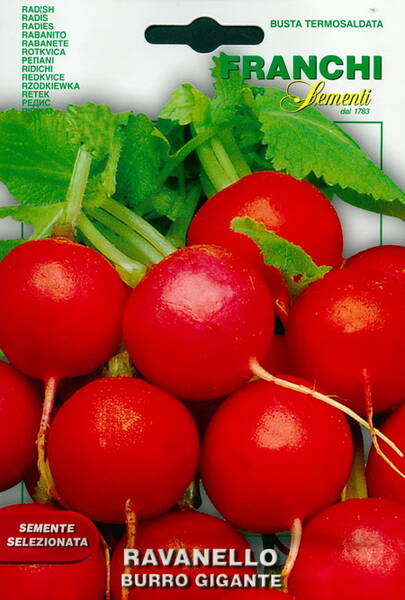Ex Tax: 1.35€
Medium early grade. Technically ready 30-32 days after germination. Sow in open ground in April, May, 50 seeds per 1 m of the garden.
Number of seeds in 1,0 g = 100-120 pc.
Agrotechnology: for sowing radishes, a site is chosen that comes out early from under the snow, with light, highly fertile soil.
The predecessors of radish can be any vegetable, except for the cruciferous family. Fertilizers are applied to the soil before sowing.
Radish is sown at several times: at the end of April (the garden bed is covered with a film until shoots appear), then, if necessary,
sowing is carried out at intervals of 2-2.5 weeks, for winter storage, late-ripening varieties are sown in early August.
Seeds are sown in rows with row spacing of 10-12 cm, the distance between seeds is 2-3 cm to a depth of 1-1.5 cm.
After the emergence of seedlings, it is necessary to regularly loosen the soil and keep it moist.
It is recommended to shade in the middle of summer with the longest daylight hours of planting radishes.
To obtain an earlier and later harvest, radishes are grown in greenhouses (in spring, seeds are sown in early March, in autumn - in early September).
* We cannot help but admire the wonders of nature that created this magnificent vegetable.
Radish is used fresh for the preparation of salads, okroshka, in combination with green onions and other early vegetables.
Not only root crops, but also tender leaves are eaten. In the spring they are put in soup and salad, and in the fall or winter, the leaves can be dried or canned.
Radish improves digestion. It contains substances that inhibit the growth of harmful microbes.
Thanks to this, the radish helps the human body, weakened during the winter, to resist infections.
Radish is an annual root vegetable. In Europe, it has been bred since the 16th century.
Radish roots contain easily digestible carbohydrates, proteins, vitamins: C, B2, PP, P, fiber, mineral salts, as well as mustard and essential oils, up to 5 g per 1 kg of dry matter.
There are especially many potassium salts in radishes, which strengthen the heart. Contained in radishes and organically bound sulfur.
Radish grows best with a short day, less than 12 hours. If the day is long, flowering shoots appear prematurely, and root crops are formed unsuitable for food.
With thickened cultivation and a lack of moisture, the roots become coarse, lose their juicy properties, become flabby and,
without reaching the technical consumer ripeness, give flowering shoots.
Radish can withstand frosts down to -5 ...- 6 ° C, but the development of root crops is greatly slowed down and flowering shoots are formed.
Radish seeds germinate at + 4.5 + 5 ° С, but they do not germinate for a long time. At + 10 + 15 ° С, seedlings appear in 7-12 days, and at + 20 + 22 ° С - after 3-4 days.
To get a good harvest of radish, plots with light loamy soils are allocated for it, which are dug up and fertilized with rotted compost.
For digging, nitrogen, phosphorus and potash fertilizers are applied, up to 30 g per 1 sq. m. The plot should be warmed up by the sun and protected from winds.
Radish can be sown after any vegetable crop, except cabbage crops.
It is often cultivated as a catch crop: before planting a cucumber or tomato, before planting later varieties of cauliflower, before planting a turnip.
Radish can be sown closer to autumn, after harvesting early potatoes and in the aisles of plantings of cucumbers or cabbage.
In autumn, radishes are sown in early August, and in warm weather, in September.
A good result is obtained by sowing of radish before winter, while root crops are formed larger and of better quality than with spring sowing.
For 1 sq. m 2-7 g of seeds are sown, they are sealed to a depth of 2-3 cm. Then the ridges are mulched with humus or peat, with a layer of 2-3 cm, and covered with a film.
Seeds for sowing are selected large, more than 2.5 cm, because small seeds will give plants that bloom.
To accelerate the emergence of seedlings, the seeds are soaked in water for a day. When the first true leaf appears, the seedlings are thinned out,
leaving a distance between them: for early-ripening varieties 4-5 cm, and for mid-ripening varieties - 6-7 cm.
Watering radishes is carried out every 2-3 days, and in dry weather - every day, preferably in the evening, and after watering the soil is loosened.
Top dressing is carried out with mullein infusion or liquid fertilizer from nettle, 1 time in 7-10 days.
To protect against cruciferous fleas, crops are pollinated with a mixture of ash and tobacco dust, they are taken in equal proportions.
In the fall, the flea is less harmful, therefore it is more promising to grow radishes in the fall, right up to frost, you can grow it after harvesting cucumbers in a greenhouse.
The radish root system releases substances that are detrimental to cucumber plants; therefore,
radishes are grown in a cucumber greenhouse both before the cucumbers are planted in it, and after they are harvested.
Root crops of different varieties of radish are very diverse in shape and color.
Early ripening varieties form a root crop in 20-30 days from germination, later varieties - in 40-60 days. The diameter of the root crop can be 3 cm or more.
Eng.: Radish. Bot.: Raphanus sativus L. var. sativus.












